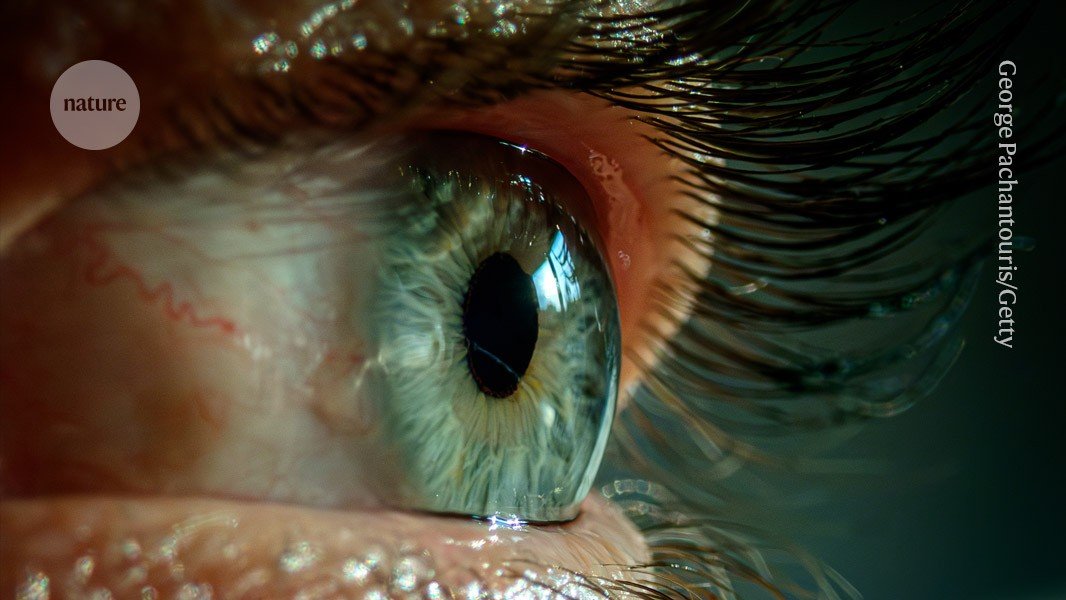
Brand-new colour created by tricking human eyes with laser

Researchers used lasers to stimulate individual cone cells in the retina — leading to the perception of a completely new colour.Credit: George Pachantouris/Getty
Five people have been able to perceive a colour never before seen by human eyes, after researchers used lasers and tracking technology to selectively activate certain cells in their retinas. The blue-greenish hue has an intensity, or ‘saturation’, outside the natural range of colours seen by humans.
The work is “amazing technically” and an “extraordinary achievement”, says Kimberly Jameson, a colour-vision scientist at the University of California, Irvine.
This is not the first time researchers have stimulated individual cone cells — the photoreceptors in the eye whose signals the brain interprets as colour. But this time it was done across an area large enough to alter a person’s vision substantially. “What is novel in this study is the evidence that such new colours can, in fact, be perceived,” says Sérgio Nascimento, a physicist specializing in human vision at the University of Minho in Braga, Portugal.
Off-the-charts intense
The researchers, who published details of the technique in Science Advances on 18 April1, call the otherwise imperceptible colour ‘olo’. It is something like a peacock blue or teal, “but the level of saturation is off-the-charts”, says Ren Ng, a computer scientist and vision researcher at the University of California, Berkeley, who was both a co-author of the study and one of the test participants.
The method — dubbed Oz and run by software called Wizard — works by controlling the precise doses of light delivered to each cell in the retina, to spoof the signals the brain uses to interpret colour or to create signals it has never experienced before.
Ng says the technique has the potential to create other new colours. It could also allow people with colour blindness, for which there are no effective treatments, to perceive differences in hue that they would not otherwise, he says.
That would take a lot of work. So far, the team can carefully control colour in just a small area of vision — roughly twice the diameter that the Moon appears to cover in the sky — and the method requires technology available to very few labs. But, even if it doesn’t end up being applied widely, the research is “an impressive technical accomplishment”, says Jenny Bosten, a visual neuroscientist at the University of Sussex in Brighton, UK. “There is a lot of potential for future research using the technique.”
Fingerprints of light
Human colour vision comes from the brain comparing the signals it receives from three types of light-detecting cone cell. Each one is sensitive to a different but overlapping range of wavelengths. At shorter, bluer wavelengths, the S cone is most responsive, whereas the M, or medium, cone is activated most by greenish light. The L cone is moresensitive than the others to longer-wavelength red light. Every colour that humans can see comes to the brain as a characteristic level of activation of these three cell types, analogous to a fingerprint or set of coordinates.
Because the M cone is in the middle of the spectrum, light activating it always activates neighbouring S or L cones, as well. Ng and his colleagues wondered whether, if the M cone was stimulated by itself, it would create a new colour.
The team first mapped the retinas of each trial participant, marking the position and type of each cell, using a technique developed by co-authors based at the University of Washington in Seattle2. This allowed them to track each person’s eye movements and train laser light on individual cone cells.
They then stimulated just the M cones with microdoses of laser light. To test what the participants were seeing, the team asked them to match the colour they perceived with examples of light of a single wavelength. There was no match — the olo colour seemed to be more intense than even the most vibrant blue-green colour possible in normal vision. Participants had to ‘wash out’ the olo colour by adding white light to make it match the closest natural colour, says Ng.




